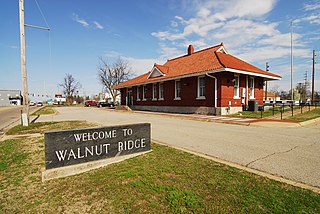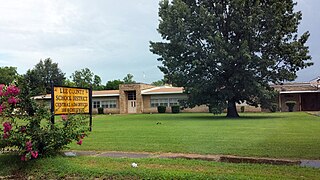| Hoxie School District | |
|---|---|
| Location | |
| 305 SW Alice Street Hoxie, Arkansas 72433 United States | |
| District information | |
| Grades | PK–12 |
| Accreditation | ADE |
| Schools | 3 [1] |
| District ID | 0507990 [1] |
| Students and staff | |
| Students | 1,012 [1] |
| Teachers | 85.10 (on FTE basis) [1] |
| Staff | 168.10 (on FTE basis) [1] |
| Student-teacher ratio | 11.89 [1] |
| District mascot | Mustang |
| Colors | Green White |
| Other information | |
| Website | hoxieschools |
Hoxie School District is a public school district based in Hoxie, Arkansas, United States. The Hoxie School District encompasses 124.17 square miles (321.6 km2) of land including all or portions of Lawrence County communities including Hoxie, small portions of Walnut Ridge, Sedgwick, and Minturn. [2]
A school district is a special-purpose district that operates local public primary and secondary schools in various nations.

Hoxie is a town in Lawrence County, Arkansas, United States. It lies immediately south of Walnut Ridge. The population was 2,780 at the 2010 census.
Education in the United States is provided in public, private, and home schools.
Contents
Hoxie School District provides early childhood, elementary and secondary education for more than 1,100 prekindergarten through grade 5 and grades 8 through 12 at its two facilities. Hoxie School District schools are accredited by the Arkansas Department of Education (ADE) and by AdvancED.
Early childhood education is a branch of education theory which relates to the teaching of children from birth up to the age of eight which is traditionally about third grade. It emerged as a field of study during the Enlightenment, particularly in European countries with high literacy rates. It continued to grow through the nineteenth century as universal primary education became a norm in the Western world. In recent years, early childhood education has become a prevalent public policy issue, as municipal, state, and federal lawmakers consider funding for preschool and pre-K. It is described as an important period in a child's development. It refers to the development of a child's personality. ECE is also a professional designation earned through a post-secondary education program. For example, in Ontario, Canada, the designations ECE and RECE may only be used by registered members of the College of Early Childhood Educators, which is made up of accredited child care professionals who are held accountable to the College's standards of practice.

Secondary education covers two phases on the International Standard Classification of Education scale. Level 2 or lower secondary education is considered the second and final phase of basic education, and level 3 (upper) secondary education is the stage before tertiary education. Every country aims to provide basic education, but the systems and terminology remain unique to them. Secondary education typically takes place after six years of primary education and is followed by higher education, vocational education or employment. Like primary education, in most countries secondary education is compulsory, at least until the age of 16. Children typically enter the lower secondary phase around age 11. Compulsory education sometimes extends to age 19.

The Arkansas Department of Education (ADE), headquartered in Little Rock, is the state education agency of Arkansas for public schools. Founded in 1931, its responsibilities include accrediting schools, assisting Arkansas schools and their school districts in developing their curricula, approving the textbooks used in state public schools, licensing teachers, and providing continuing education programs. The ADE consists of five divisions: Division of Academic Accountability, Division of Fiscal and Administrative Services, Division of Human Resources, Division of Learning Services, and Division of Research and Technology.







